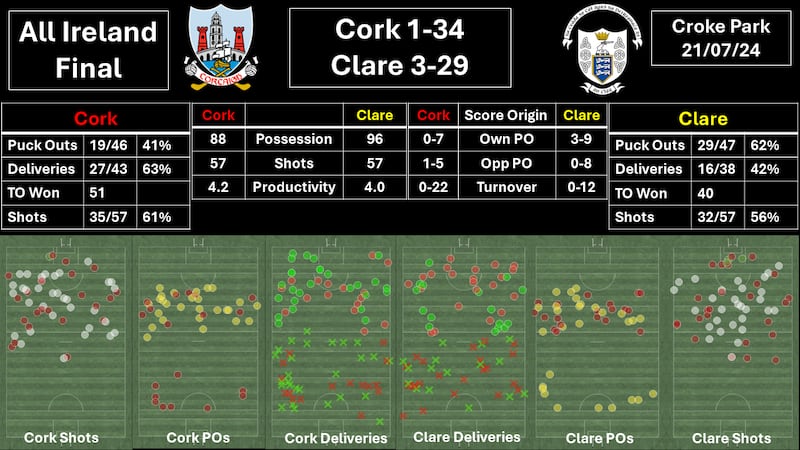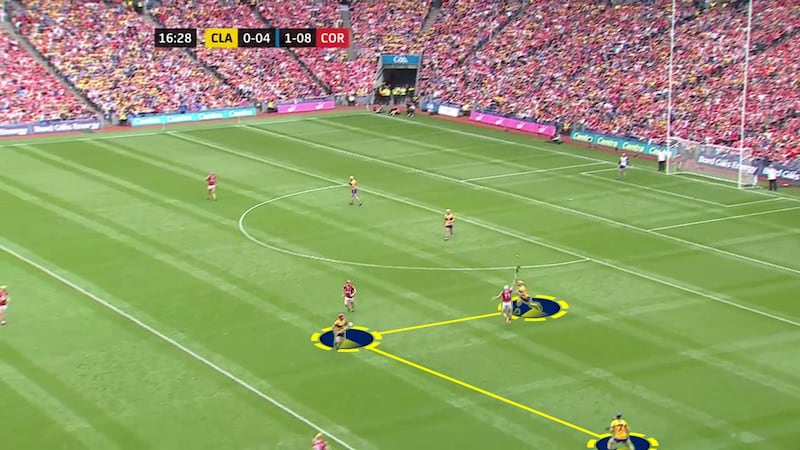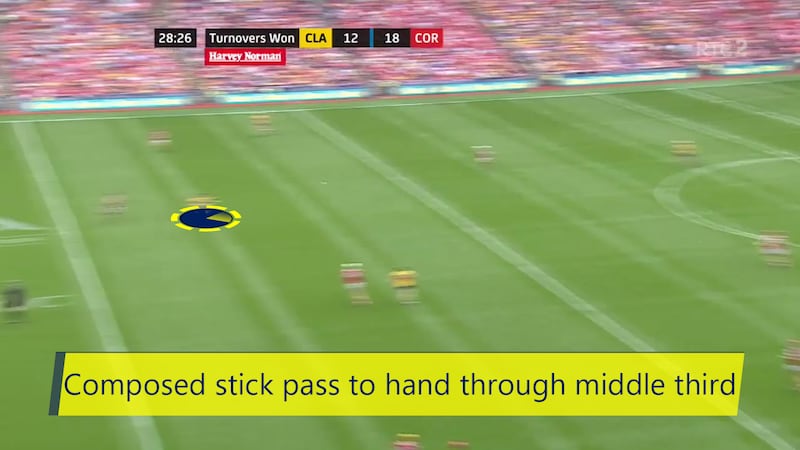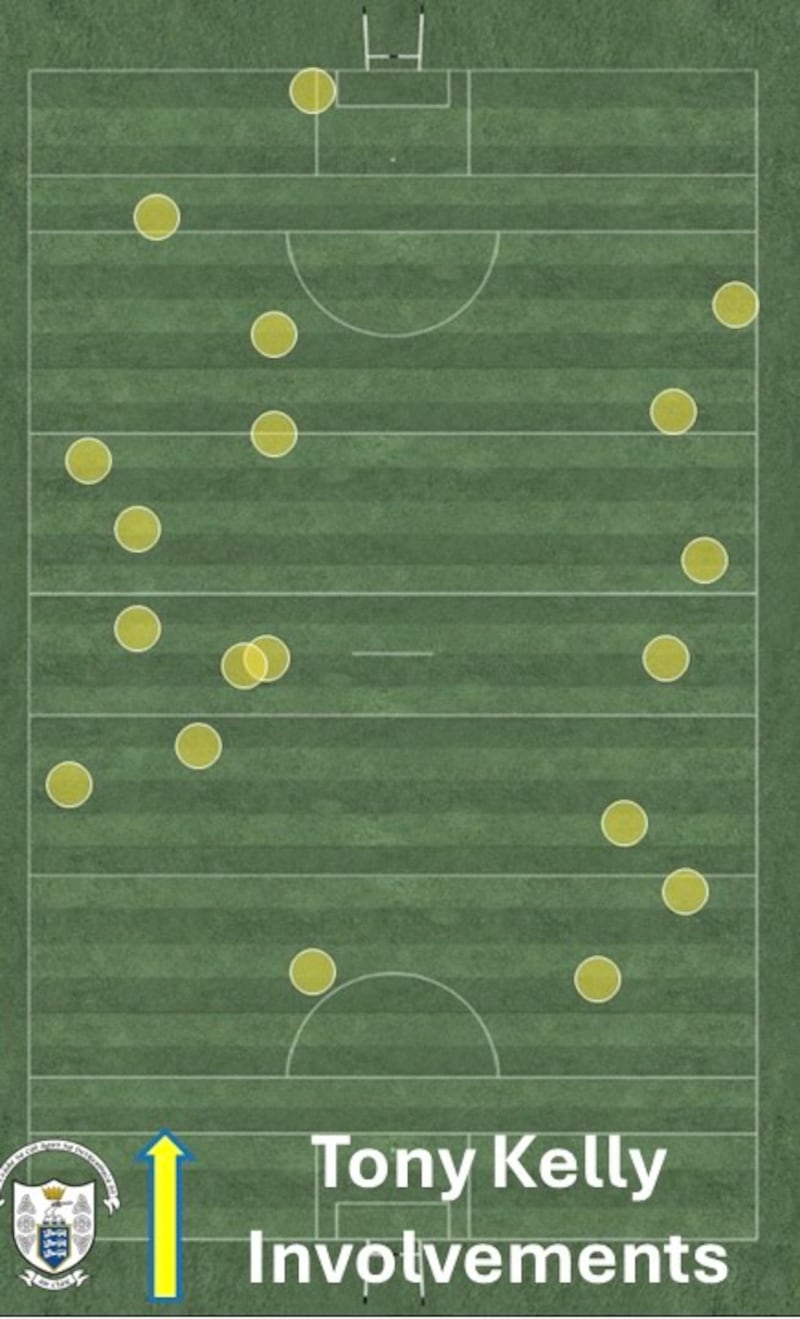Albert Einstein said “Everything that can be counted does not necessarily count and everything that counts cannot necessarily be counted.” I’ll try to measure some of the things that mattered in the All-Ireland final between Cork and Clare – however, it is very difficult to measure the genius of Tony Kelly, the doggedness of John Conlon, the youthful craft of Adam Hogan and Conor Leen or the execution of “spoiling” by Conor Cleary.
There were areas of the contest that Clare dominated, but there were also areas of the game where Cork flourished. Cork delivered excellent ball into their forwards throughout, shot efficiently and dominated the turnover stakes. They won the turnover battle by 51-40, and this was a key scoring source for them, leading to 0-22.

Cork puckout
The puckout numbers for Cork were extremely poor, even more so when you consider the joy Cork got off their own puckout in the two encounters against Limerick. Clare really had a strong grip on the Cork puckout.
In the first half, Patrick Collins had 19 puck outs in total. He sent 14 of these long and Clare won 13/14 – David McInerney won two clean aerially and Clare won 11/12 on breaking ball. Even more worryingly for Cork was their inability to work the short puckout to a possession in the Clare half. They did not manage to retain possession beyond the halfway line on any of their five short puckouts in the first half. Cork had no scoring return off their puckout in the first half.
READ MORE

The same approach they used of moving onto breaks against Limerick was stunted as Clare spoiled aerially and checked runs as Cork flooded to the breaking ball area. Conlon checking the runs of Shane Barrett to the breaking ball zone and Cleary spoiling Brian Hayes aerially were two of the key facets here.
Cork’s puck out did improve after half time but they only managed to return 0-7 from 46 puckouts over the course of the 90 minutes. That is a mere return of 0.15 points per puckout. Cork also went short a total of eight times and they didn’t get a score from any of these eight, with six resulting in turnovers and two missed shots.
Cork puckout
The Clare puckout functioned significantly better than Cork’s. Clare got a return of 3-9 from their own puckout. That’s 0.38 points per puck out, a big difference to Cork’s when you consider it is such a vital component of the game.
One of the big areas of contrast was Clare’s ability to work their short puckouts to possessions in the far end of the field. Clare had nine short puckouts, retained possession into the Cork half with six of these, scored 1-2 and it could have been more as another two goal chances came from these, in the form of Diarmuid Ryan and Shane O’Donnell being blocked as they shot at goal.
Clare variety in how they used ball out of defence was a key attribute, as they mixed up running the ball, mid-range stick passes and long deliveries.


The genius of Tony Kelly
Tony Kelly was masterful. He produced in big moments during the game. In his post-match interview, it was interesting to hear him reflect on his goal, as he said the way Cork defended, ready to block him from shooting for a point meant he had to carry the ball and a gap opened for him.
But all of his scores came at clutch moments in the game. He was all over the field, he registered 1-4, every one of them a sublime score. He assisted 0-2 and had an involvement in another 0-2. His contributions weren’t all in the attacking half of the field either, as he also helped in the defensive stakes. He won three Cork puckouts breaks in his own half-back line, along with one Clare puckout in injury time where he scored a wonder point on the spin.
The possession map of Kelly shows how he operates on the edges, bringing magic from out on the wings when he comes inside with the ball.

While Tony Kelly won man of the match he could easily have been overshadowed by David Fitzgerald if his shooting boots were on.
Fitzgerald managed to have 12 shots at the posts, but only managed 0-3, 25% shooting efficiency. He had a goal chance blocked in extra time after Kelly set him up, and had eight other point attempts which didn’t result in scores. It took HawkEye to decide two of them were wide. He had a total of 22 possessions, delivering seven long balls into the Clare attack.
He also won the puckout leading to Tony Kelly’s goal, as he caught the ball and offloaded to the Ballyea man. Fitzgerald’s positioning as an outlet ball for the backs in what was almost a half back position caused serious bother for Cork.
His match up with Mark Coleman was one of the few in the game which wasn’t a traditional stand-up battle. As a result of Fitzgerald’s positioning and his influence on the game, Coleman also had a huge role for Cork offensively. He scored 0-3 and was a major platform for Cork’s attack, as he hit six long deliveries to the Cork forwards over the contest, leading to 0-2.

Defending in hurling
Watching the game, I couldn’t help but think that the punishment for illegally stopping a clear goalscoring chance is too severe. A penalty and a 10-minute sin bin puts backs into a position where they are not willing to make tackles that at club level they would do instinctively (as the rule isn’t in place there).
We were lucky to see three amazing individual goals, but the lack of physicality in stopping the goals was evident, as the goal scorers carried direct through the opposition defences. For the Rob Downey goal, it was possibly a mix of the rule, along with the limitations of man marking.
Even for the Aidan McCarthy goal, Ciaran Joyce had a hold of Shane O’Donnell before releasing him and when O’Donnell got it back Cork tried to stop him legally but couldn’t. That might be harsh on defenders but equally there was a 90-second spell from Clare from the 30th minute where they rattled off 0-3, with incredible direct ball carrying, support runs and skill execution – unmarkable attacking play.
As usual with hurling there was much more that occurred than we can cover here, and the game is likely to be remembered for moments of magic and huge individual displays from the likes of Diarmuid Ryan, Conor Leen and Adam Hogan. The Clare men maxed out but this Cork team is here to stay, and there are likely higher gears in many of them.
Paul O’Brien is a performance analyst with The Performance Process (twitter.com/NoPlanBGAA).














